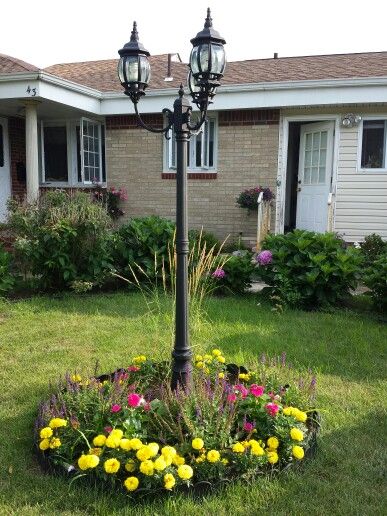After some shopping on the internet. A very stylish lamp-post arrived with instructions. Well to install a lamp-post you need electric and you need a foundation.

While often thought of as a purely functional and practical type of safety lighting for outdoor spaces the post lights in this collection can bring a lot of decorative character to your driveway and front yard.

Front Yard Lamp Post. If you follow my articles you might have read that I installed a glass block window and brought the electric line out of the house in the corner of one of these windows. I was thinking ahead. So that line, using direct burial cable. I brought that forward to the right front corner and put up a plug, in a water proof box.
Most of us now recognize both the need and charm of residential outdoor lighting. Attempting to light the outdoors portion of your home however is different from indoor or commercial lighting. Here are some things that you need to remember if you decide to install such lighting for your home. And then nice residential lamp posts can be found in front of your house.
Make a Plan
There are two ways for you to plan for installing residential types of lighting. Some recommend that you finish everything first before planning for lights while others say that you should plan the placement of your outdoor lights even before your outdoor structures and landscapes are completed. Either way would work and your plans will depend on your preference.
Keep Changes to a Minimum
You wouldn’t want to redo a recent outdoor or landscaping project though just to accommodate the garden lighting. Aside from planning, you should also carefully plot your property and potential residential garden lighting locations before you begin on your lighting project.
Use Variety
Be creative. Don’t just settle for buying just one set of lamps or one set of embedded lights. Try to consider the idea of using a variety of residential outdoor lighting fixtures and items. Paths and driveways for example can be illuminated by lamp posts while landscapes, shrubs and focal objects can be illuminated by spotlights, backlights or uplights. Wall mounted lights, tiki torches, lanterns and table lamps are also possible options for residential outdoor lighting.
Ask an Expert
Consider asking the help of an expert if you’re not familiar with installing the lighting yourself. Be careful though because some individuals who claim that they know about residential outdoor lighting simply read off catalogs and learn through hit or miss. Get an installer who has a good reputation and who has been installing residential outdoor lighting for a living for some time already.
Check Building Codes
Before you even connect a single wire, make sure that you have checked installation and building codes. This is not just a matter of complying with a set of rules. This is a matter of keeping your family and neighbors safe from faulty wiring or installation.
Practice Electrical Safety
One of the most important things is for you to make sure that the lighting is safe to use at all times. Although product qualities are often quality controlled, you should do your part in ensuring safety. You should for example consider having separate external electrical split receptacles instead of using extension cords. You can also choose to install ground fault circuit interrupters near pools or wet areas. Both precautions can help prevent electrocution.


















